A Novel Approach for the Biological Desalination of Major Anions in Seawater Using Three Microalgal Species: A Kinetic Study
Abstract
1. Introduction
2. Materials and Methods
2.1. Seawater Sample Collection
2.2. Physical and Chemical Analyses of the Collected Samples
2.3. Algae Species Isolation and Algal Bioassay Procedures for Biodesalination
2.4. Biodesalination under High Radiation Light Intensity and CO2 Supply
2.5. Desalination Rate Assessment of Chlorides
2.6. Application of Kinetic Modeling
- -
- Pseudo First-Order Equation:where k1 (1/day) is the rate constant of a pseudo first-order equation, and Qe (mg/g) and Qt (mg/g) are the concentrations of bioaccumulated chlorides in the living algal cell at equilibrium and at time t (day), respectively. A straight line of ln (Qe − Qt) versus t suggests that this kinetic model is applicable to the data.
- -
- Pseudo Second-Order Equation:where k2 (mg/g day) is the rate constant of a pseudo-second order equation, and Qe (mg/g) is the concentrations of accumulated salts at equilibrium.
2.7. Characterization of Dried Algal Biomass
3. Results and Discussion
3.1. Physical and Chemical Characterization of the Collected Samples
3.2. Effect of the Salinity Concentration on the Rate of Chloride Biodesalination
3.3. Effect of the Incubation Period on the Rate of Biodesalination
3.4. Effect of High Light Radiation Intensity and CO2 Supply on the Rate of Biodesalination
3.5. Kinetic Modeling for Biodesalination
3.5.1. Kinetics of Chloride Bioaccumulation by Algae under Control Conditions
3.5.2. Kinetic Modeling under High Light Intensity and CO2 Supply
3.6. The Effect of Sea Water on Algal Morphological Changes
3.7. Characterization of Dried Algal Biomass
3.7.1. Energy Dispersive X-ray Microanalysis (EDX)
3.7.2. Scanning Electron Microscopy (SEM) Analysis of Dried Algal Biomass
4. Conclusions and Recommendations
Author Contributions
Funding
Acknowledgments
Conflicts of Interest
References
- Abdel-Raouf, N.; Al-Homaidan, A.A.; Ibraheem, I.B.M. Microalgae and wastewater treatment. Saudi J. Biol. Sci. 2012, 19, 257–275. [Google Scholar] [CrossRef] [PubMed]
- Panhwar, M.Y.; Panhwar, S.; Keerio, H.A.; Khokhar, N.H.; Shah, S.A.; Pathan, N. Water quality analysis of old and new Phuleli Canal for irrigation purpose in the vicinity of Hyderabad, Pakistan. Water Pract. Technol. 2022, 17, 529–536. [Google Scholar] [CrossRef]
- Bigas, H. The Global Water Crisis: Addressing an Urgent Security Issue; United Nations University—Institute for Water, Environment and Health: Hamilton, ON, Canada, 2012; 176p. [Google Scholar]
- Chen, C.; Jiang, Y.; Ye, Z.; Yang, Y.; Hou, L. Sustainably integrating desalination with solar power to overcome future freshwater scarcity in China. Glob. Energy Interconnect. 2019, 2, 98–113. [Google Scholar] [CrossRef]
- Samad, N.A.; Bruno, V.L. The urgency of preserving water resources. Environ. News 2013, 21, 3–6. [Google Scholar]
- McGinn, P.J.; Dickinson, K.E.; Park, K.C.; Whitney, C.G.; MacQuarrie, S.P.; Black, F.J.; Frigon, J.-C.; Guiot, S.R.; O’Leary, S.J. Assessment of the bioenergy and bioremediation potentials of the microalga Scenedesmus sp. AMDD cultivated in municipal wastewater effluent in batch and continuous mode. Algal Res. 2012, 1, 155–165. [Google Scholar] [CrossRef]
- Pittman, J.K.; Dean, A.P.; Osundeko, O. The potential of sustainable algal biofuel production using wastewater resources. Bioresour. Technol. 2011, 102, 17–25. [Google Scholar] [CrossRef] [PubMed]
- Gorjian, S.; Ghobadian, B. Solar desalination: A sustainable solution to water crisis in Iran. Renew. Sustain. Energy Rev. 2015, 48, 571–584. [Google Scholar] [CrossRef]
- Sehn, P. Fluoride removal with extra low energy reverse osmosis membranes: Three years of large scale field experience in Finland. Desalination 2008, 223, 73–84. [Google Scholar] [CrossRef]
- Mezher, T.; Fath, H.; Abbas, Z.; Khaled, A. Techno-economic assessment and environmental impacts of desalination technologies. Desalination 2011, 266, 263–273. [Google Scholar] [CrossRef]
- Al-Odwani, A.; El-Sayed, E.E.F.; Al-Tabtabaei, M.; Safar, M. Corrosion resistance and performance of copper–nickel and titanium alloys in MSF distillation plants. Desalination 2006, 201, 46–57. [Google Scholar] [CrossRef]
- Ashwaniy, V.R.V.; Perumalsamy, M. Reduction of organic compounds in petro-chemical industry effluent and desalination using Scenedesmus abundans algal microbial desalination cell. J. Environ. Chem. Eng. 2017, 5, 5961–5967. [Google Scholar] [CrossRef]
- Wang, S.; Yang, S.; Jin, X.; Liu, L.; Wu, F. Use of low cost crop biological wastes for the removal of Nitrobenzene from water. Desalination 2010, 264, 32–36. [Google Scholar] [CrossRef]
- Doma, H.; Moghazy, R.; Mahmoud, R. Environmental factors controlling algal species succession in High Rate Algal Pond. Egypt. J. Chem. 2021, 64, 729–738. [Google Scholar] [CrossRef]
- El-Kamah, H.M.; Badr, S.A.; Moghazy, R.M. Reuse of Wastewater Treated Effluent by Lagoon for Agriculture and Aquaculture Purposes. Aust. J. Basic Appl. Sci. 2011, 5, 9–17. [Google Scholar]
- El-Kamah, H.M.; Doma, H.S.; Badr, S.; El-Shafai, S.A.; Moghazy, R.M. Removal of fecal coliform from HFBR effluent via stabilization pond as a post treatment. Res. J. Pharm. Biol. Chem. Sci. 2016, 7, 1897–1905. [Google Scholar]
- Moghazy, R.M.; Labena, A.; Husien, S.; Mansor, E.S.; Abdelhamid, A.E. Neoteric approach for efficient eco-friendly dye removal and recovery using algal-polymer biosorbent sheets: Characterization, factorial design, equilibrium and kinetics. Int. J. Biol. Macromol. 2020, 157, 494–509. [Google Scholar] [CrossRef]
- Moghazy, R.M.; Labena, A.; Husien, S. Eco-friendly complementary biosorption process of methylene blue using micro-sized dried biosorbents of two macro-algal species (Ulva fasciata and Sargassum dentifolium): Full factorial design, equilibrium, and kinetic studies. Int. J. Biol. Macromol. 2019, 134, 330–343. [Google Scholar] [CrossRef] [PubMed]
- Abdelhamid, A.E.; Labena, A.; Mansor, E.S.; Husien, S.; Moghazy, R.M. Highly efficient adsorptive membrane for heavy metal removal based on Ulva fasciata biomass. Biomass Conv. Bioref. 2021, 11, 1–16. [Google Scholar] [CrossRef]
- Moghazy, R.M. Activated biomass of the green microalga Chlamydomonas variabilis as an efficient biosorbent to remove methylene blue dye from aqueous solutions. Water SA 2019, 45, 20–28. [Google Scholar] [CrossRef]
- Abdelhameed, R.M.; Alzahrani, E.; Shaltout, A.A.; Moghazy, R.M. Development of biological macroalgae lignins using copper based metal-organic framework for selective adsorption of cationic dye from mixed dyes. Int. J. Biol. Macromol. 2020, 165, 2984–2993. [Google Scholar] [CrossRef]
- Badr, S.A.; Ashmawy, A.A.; El-Sherif, I.Y.; Moghazy, R.M. Non-conventional low-cost biosorbents for adsorption and desorption of heavy metals. Res. J. Pharm. Biol. Chem. Sci. 2016, 7, 3110–3122. [Google Scholar]
- Kesaano, M.; Sims, R.C. Algal biofilm based technology for wastewater treatment. Algal Res. 2014, 5, 231–240. [Google Scholar] [CrossRef]
- Nagy, A.M.; El Nadi, M.H.; Hussein, H.M. Determination of the best water depth in desalination algae ponds. El Azhar Univ. Fac. Eng. CERM Civ. Eng. 2019, 38, 1. [Google Scholar]
- Park, J.; Jin, H.-F.; Lim, B.-R.; Park, K.-Y.; Lee, K. Ammonia removal from anaerobic digestion effluent of livestock waste using green alga Scenedesmus sp. Bioresour. Technol. 2010, 101, 8649–8657. [Google Scholar] [CrossRef]
- Demetriou, G.; Neonaki, C.; Navakoudis, E.; Kotzabasis, K. Salt stress impact on the molecular structure and function of the photosynthetic apparatus—The protective role of polyamines. Biochim. Biophys. Acta 2007, 1767, 272–280. [Google Scholar] [CrossRef]
- Mohammed, A.A.; Shafea, A.A. Growth and some metabolic activities ofScenedesmus obliquus cultivated under different NaCl concentrations. Biol. Plant. 1992, 34, 423–430. [Google Scholar] [CrossRef]
- Martínez, M.E.; Sánchez, S.; Jiménez, J.M.; El Yousfi, F.; Muñoz, L. Nitrogen and phosphorus removal from urban wastewater by the microalga Scenedesmus obliquus. Bioresour. Technol. 2000, 73, 263–272. [Google Scholar] [CrossRef]
- Lewis, M.A. Use of freshwater plants for phytotoxicity testing: A review. Environ. Pollut. 1995, 87, 319–336. [Google Scholar] [CrossRef]
- Wei, J.; Gao, L.; Shen, G.; Yang, X.; Li, M. The role of adsorption in microalgae biological desalination: Salt removal from brackish water using Scenedesmus obliquus. Desalination 2020, 493, 114616. [Google Scholar] [CrossRef]
- Moghazy, R.M.; Abdo, S.M.; Mahmoud, R.H. Chapter 7—Algal Biomass as a Promising Tool for CO2 Sequestration and Wastewater Bioremediation: An Integration of Green Technology for Different Aspects; Elsevier: Amsterdam, The Netherlands, 2022; pp. 149–166. [Google Scholar]
- APHA. Standard Methods for the Examination of Water and Wastewater; APHA: Washington, DC, USA, 2017. [Google Scholar]
- Streble, H.; Krauter, D. Das Leben im Wassertropfen: Mikroflora und Mikrofauna des Süsswassers. In Ein Bestimmungsbuch; Franckh-Kosmos Verlags-GmbH & Co.: Stuttgart, Germany, 2006. [Google Scholar]
- Baker, P.D.; Fabbro, L. A Guide to the Identification of Common Blue-Green Algae (Cyanoprokaryotes) in Australian Freshwaters; Cooperative Research Centre for Freshwater Ecology: Rockhampton, Australia, 2002. [Google Scholar]
- Komárek, J. Chlorophyceae (Grunalgen), Ordnung: Chlorococcales. Phytoplankt Susswassers Syst. Biol. 1983, 7. [Google Scholar]
- Figler, A.; Dobronoki, D.; Márton, K.; Nagy, S.A.; Bácsi, I. Salt tolerance and desalination abilities of nine common green microalgae isolates. Water 2019, 11, 2527. [Google Scholar] [CrossRef]
- Almutairi, A.W.; El-Sayed, A.E.-K.B.; Reda, M.M. Evaluation of high salinity adaptation for lipid bio-accumulation in the green microalga Chlorella vulgaris. Saudi. J. Biol. Sci. 2021, 28, 3981–3988. [Google Scholar] [CrossRef] [PubMed]
- Kirrolia, A.; Bishnoi, N.R.; Singh, N. Salinity as a factor affecting the physiological and biochemical traits of Scenedesmus quadricauda. J. Algal Biomass Util. 2011, 2, 28–34. [Google Scholar]
- Stanier, R.Y.; Kunisawa, R.; Mandel, M.; Cohen-Bazire, G. Purification and properties of unicellular blue-green algae (order Chroococcales). Bacteriol. Rev. 1971, 35, 171–205. [Google Scholar] [CrossRef]
- Gan, X.; Shen, G.; Xin, B.; Li, M. Simultaneous biological desalination and lipid production by Scenedesmus obliquus cultured with brackish water. Desalination 2016, 400, 1–6. [Google Scholar] [CrossRef]
- Ho, Y.S.; Ng, J.C.Y.; McKay, G. Kinetics of pollutant sorption by biosorbents: Review. Sep. Purif. Methods 2000, 29, 189–232. [Google Scholar] [CrossRef]
- Weber, W.J.; Morris, J.C. Kinetics of Adsorption on Carbon from Solution. J. Sanit. Eng. Div. 1963, 89, 31–60. [Google Scholar] [CrossRef]
- Koyuncu, I.; Sengur, R.; Turken, T.; Guclu, S.; Pasaoglu, M.E. Advances in water treatment by microfiltration, ultrafiltration, and nanofiltration. In Advances in Membrane Technologies for Water Treatment; Woodhead Publishing: Sawston, UK, 2015; pp. 83–128. [Google Scholar]
- Christ, R.D.; Wernli, R.L., Sr. The ROV Manual: A User Guide for Remotely Operated Vehicles, the Ocean Environment; Butterworth-Heinemann: Oxford, UK, 2014; pp. 21–52. [Google Scholar]
- Vakkilainen, E.K. Steam Generation from Biomass: Construction and Design of Large Boilers; Butterworth-Heinemann: Oxford, UK, 2017; pp. 180–202. [Google Scholar]
- Christ, R.D.; Wernli, R.L., Sr. The ROV Manual: A User Guide for Remotely Operated Vehicles, Vehicle Design and Stability; Butterworth-Heinemann: Oxford, UK, 2014; pp. 107–120. [Google Scholar]
- Nessim, R.B.; Tadros, H.R.Z.; Abou Taleb, A.E.A.; Moawad, M.N. Chemistry of the Egyptian Mediterranean coastal waters. Egypt. J. Aquat. Res. 2015, 41, 1–10. [Google Scholar] [CrossRef]
- Kreitler, C.W. Geochemical Techniques for Identifying Sources of Ground-Water Salinization; CRC Press: Boca Raton, FL, USA, 1993. [Google Scholar]
- Milroy, S. Field Methods in Marine Science: From Measurements to Models; Garland Science: New York, NY, USA, 2020. [Google Scholar]
- Telahigue, F.; Agoubi, B.; Souid, F.; Kharroubi, A. Assessment of seawater intrusion in an arid coastal aquifer, south-eastern Tunisia, using multivariate statistical analysis and chloride mass balance. Phys. Chem Earth Parts A/B/C 2018, 106, 37–46. [Google Scholar] [CrossRef]
- Shirazi, S.A.; Rastegary, J.; Aghajani, M.; Ghassemi, A. Simultaneous biomass production and water desalination concentrate treatment by using microalgae. Desalin. Water Treat. 2018, 135, 101–107. [Google Scholar] [CrossRef]
- Sahle-Demessie, E.; Aly Hassan, A.; El Badawy, A. Bio-desalination of brackish and seawater using halophytic algae. Desalination 2019, 465, 104–113. [Google Scholar] [CrossRef]
- Baghour, M. Algal degradation of organic pollutants. In Handbook of Ecomaterials; Springer: New York, NY, USA, 2019; pp. 565–586. [Google Scholar]
- Min, M.; Hu, B.; Zhou, W.; Li, Y.; Chen, P.; Ruan, R. Mutual influence of light and CO2 on carbon sequestration via cultivating mixotrophic alga Auxenochlorella protothecoides UMN280 in an organic carbon-rich wastewater. J. Appl. Phycol. 2012, 24, 1099–1105. [Google Scholar] [CrossRef]
- Yang, K.-L.; Ying, T.-Y.; Yiacoumi, S.; Tsouris, A.C.; Vittoratos, E.S. Electrosorption of ions from aqueous solutions by carbon aerogel: An electrical double-layer model. Langmuir 2001, 17, 1961–1969. [Google Scholar] [CrossRef]
- Shetty, P.; Gitau, M.M.; Maróti, G. Salinity stress responses and adaptation mechanisms in eukaryotic green microalgae. Cells 2019, 8, 1657. [Google Scholar] [CrossRef] [PubMed]
- Yokoya, N.S.; De-Oliveira, E.C. Effects of salinity on the growth rate, morphology and water content of some Brazilian red algae of economic importance. Cienc. Mar. 1992, 18, 49–64. [Google Scholar] [CrossRef][Green Version]
- Ferroni, L.; Baldisserotto, C.; Pantaleoni, L.; Billi, P.; Fasulo, M.P.; Pancaldi, S. High salinity alters chloroplast morpho physiology in a freshwater Kirchneriella species (Selenastraceae) from Ethiopian Lake Awasa. Am. J. Bot. 2007, 94, 1972–1983. [Google Scholar] [CrossRef] [PubMed]
- Gautam, S.; Kapoor, D. Application of halophilic algae for water desalination. In Handbook of Algal Biofuels; Elsevier: Amsterdam, The Netherlands, 2022; pp. 167–179. [Google Scholar]
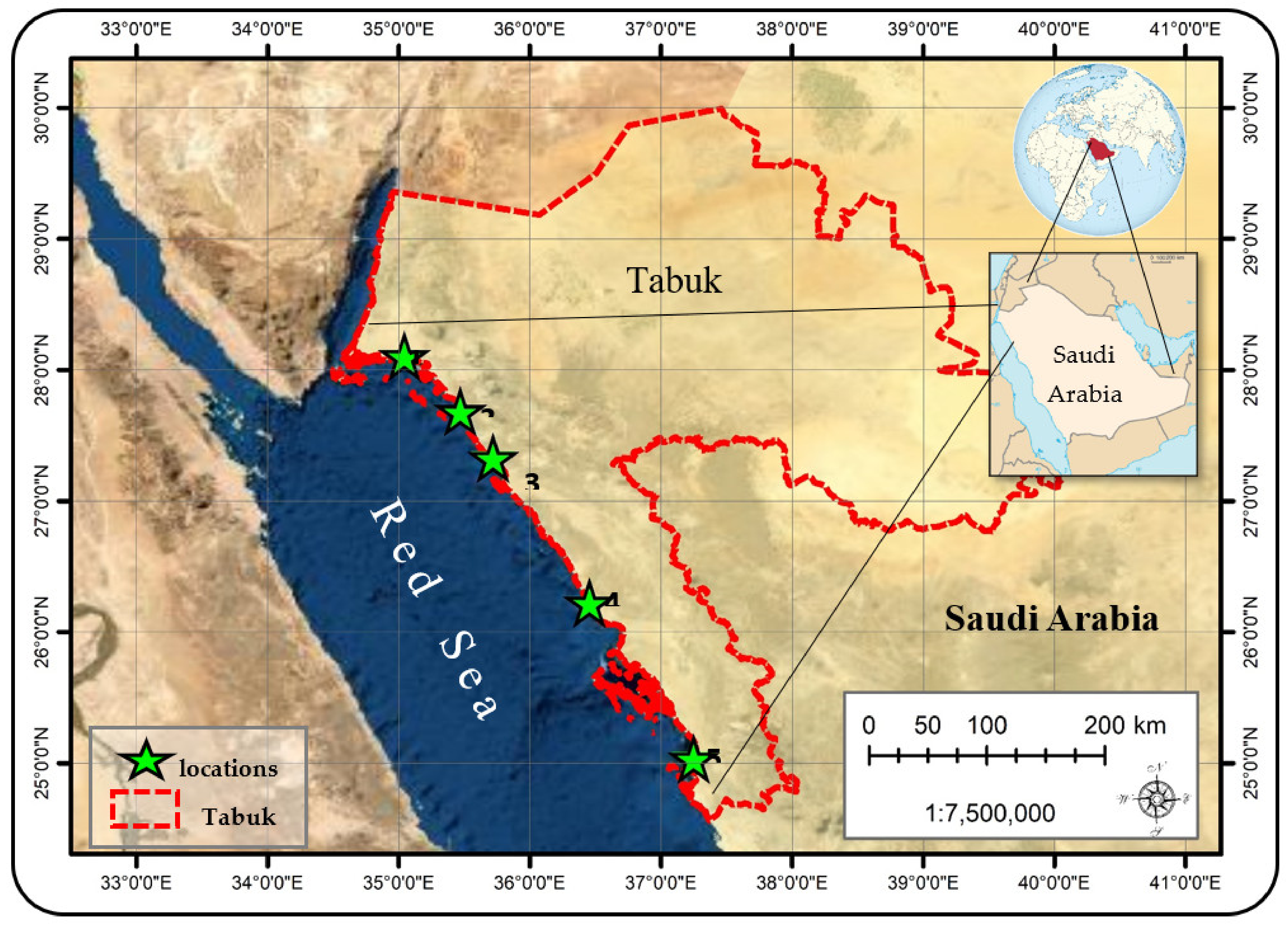
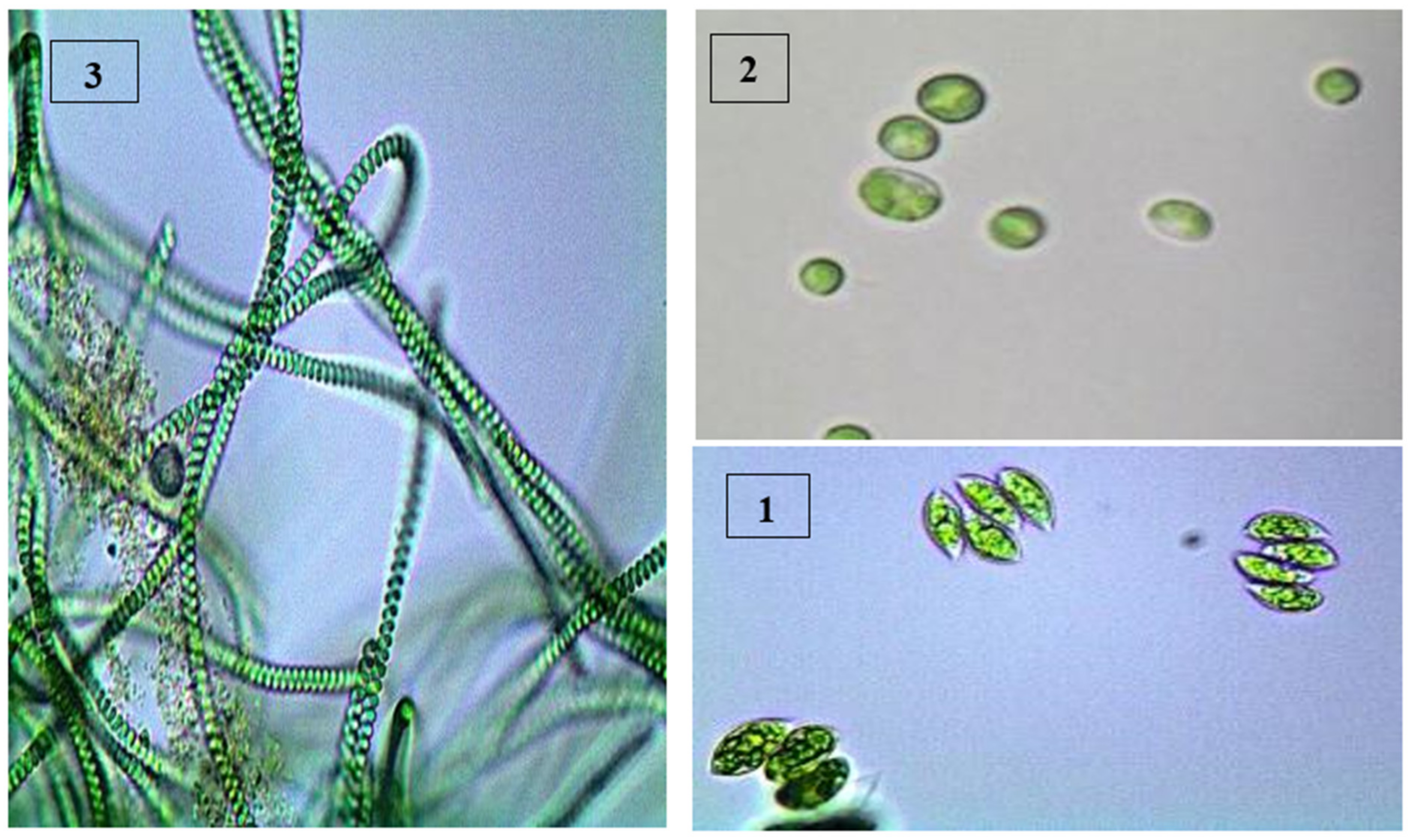
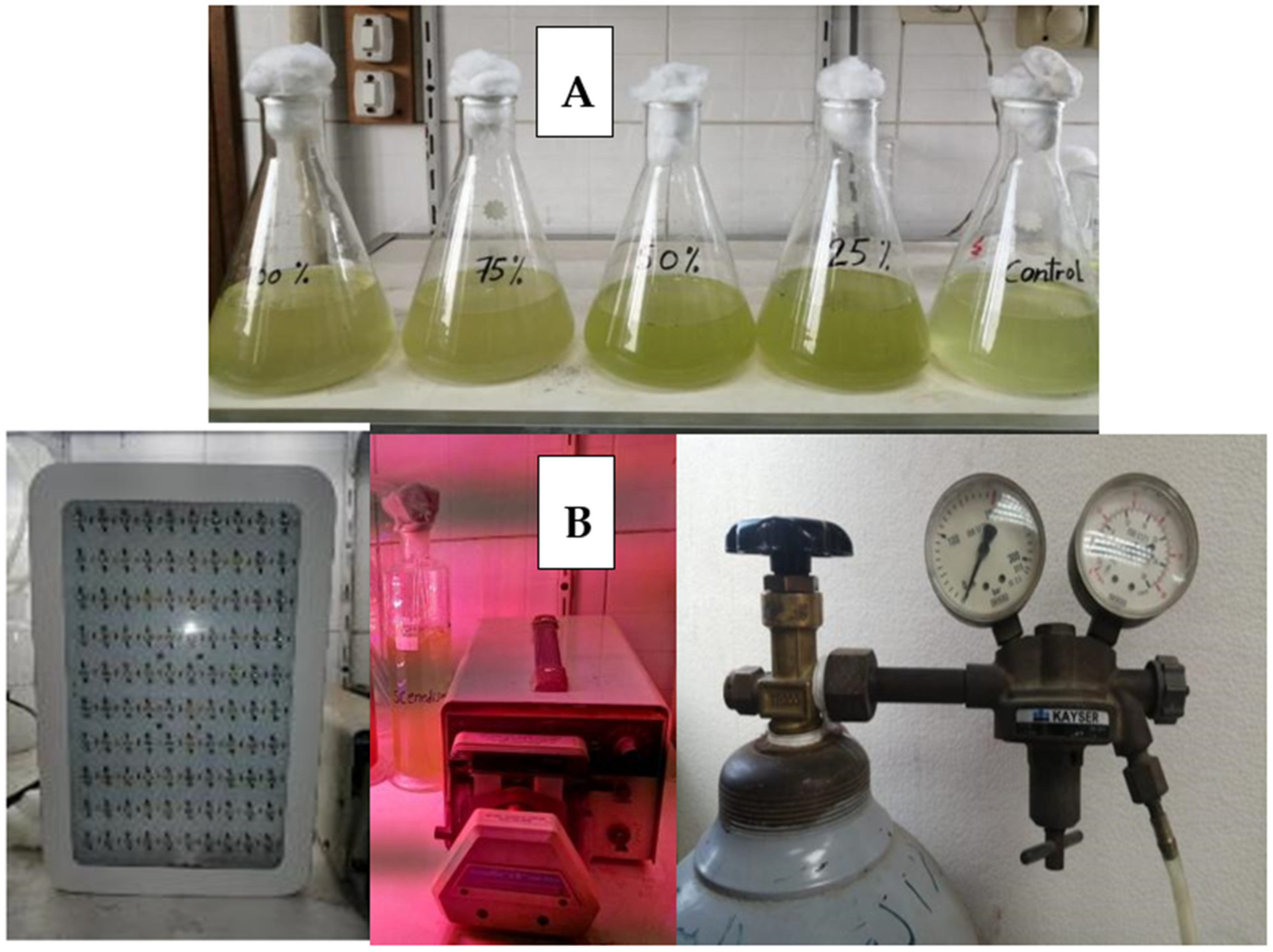
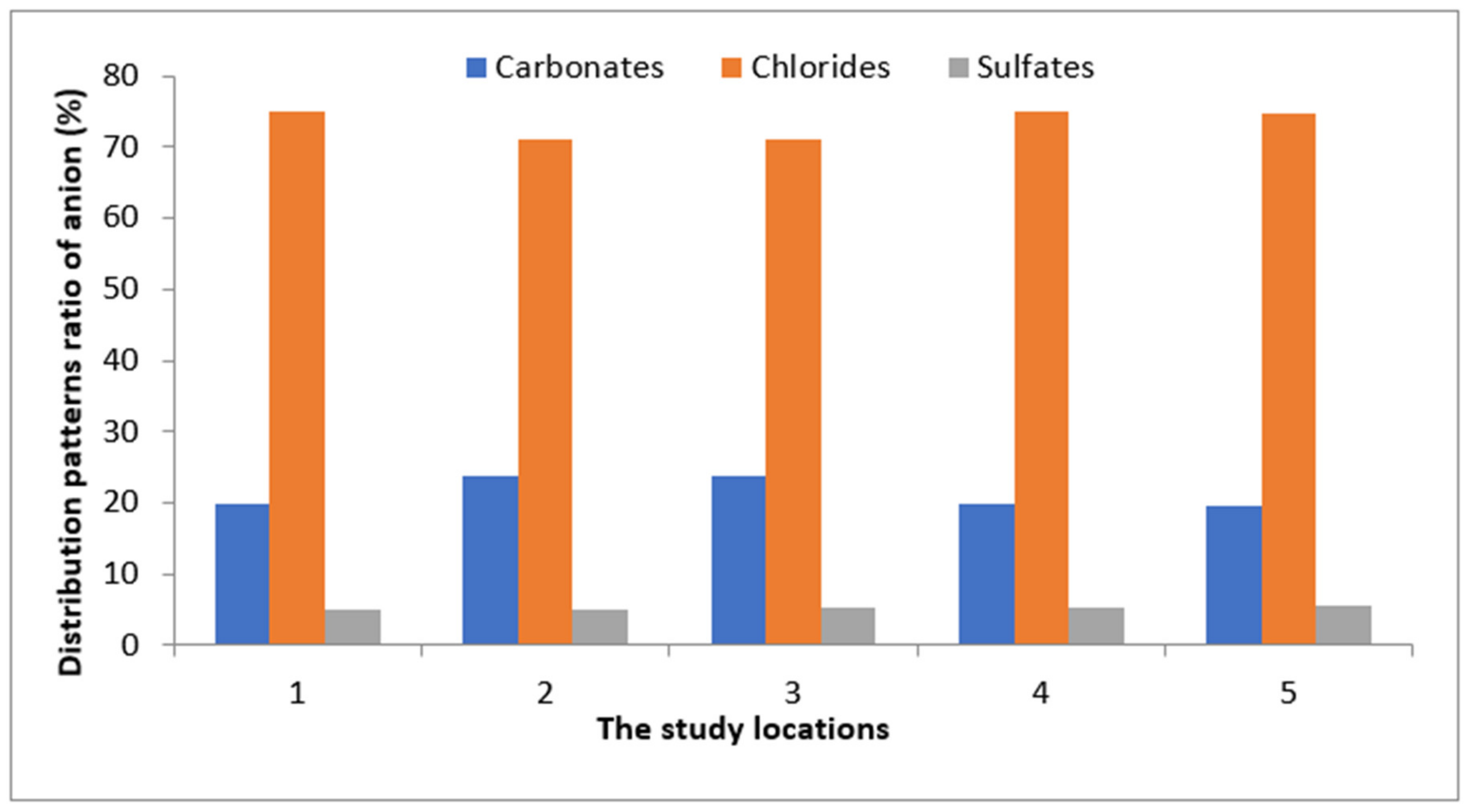

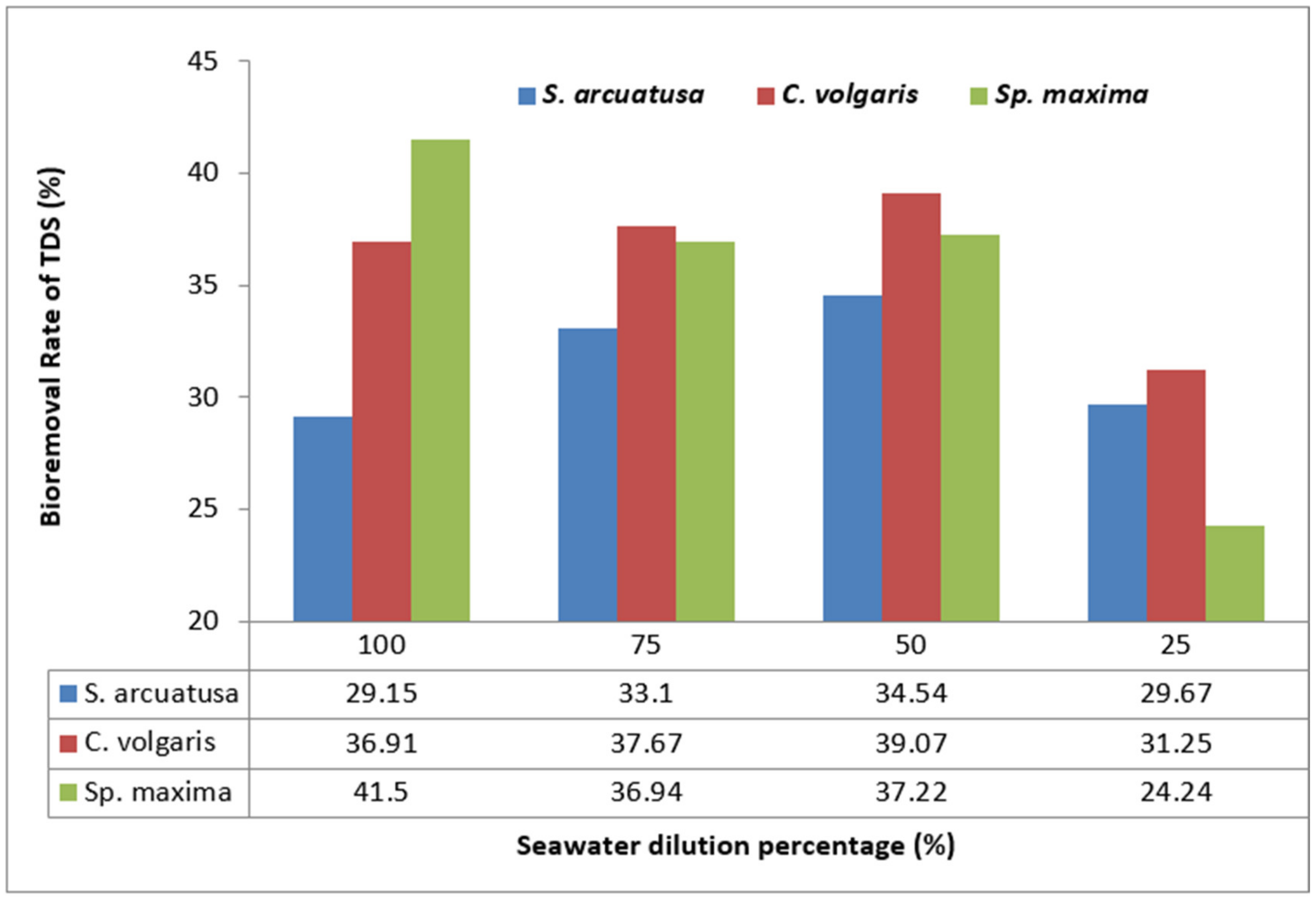
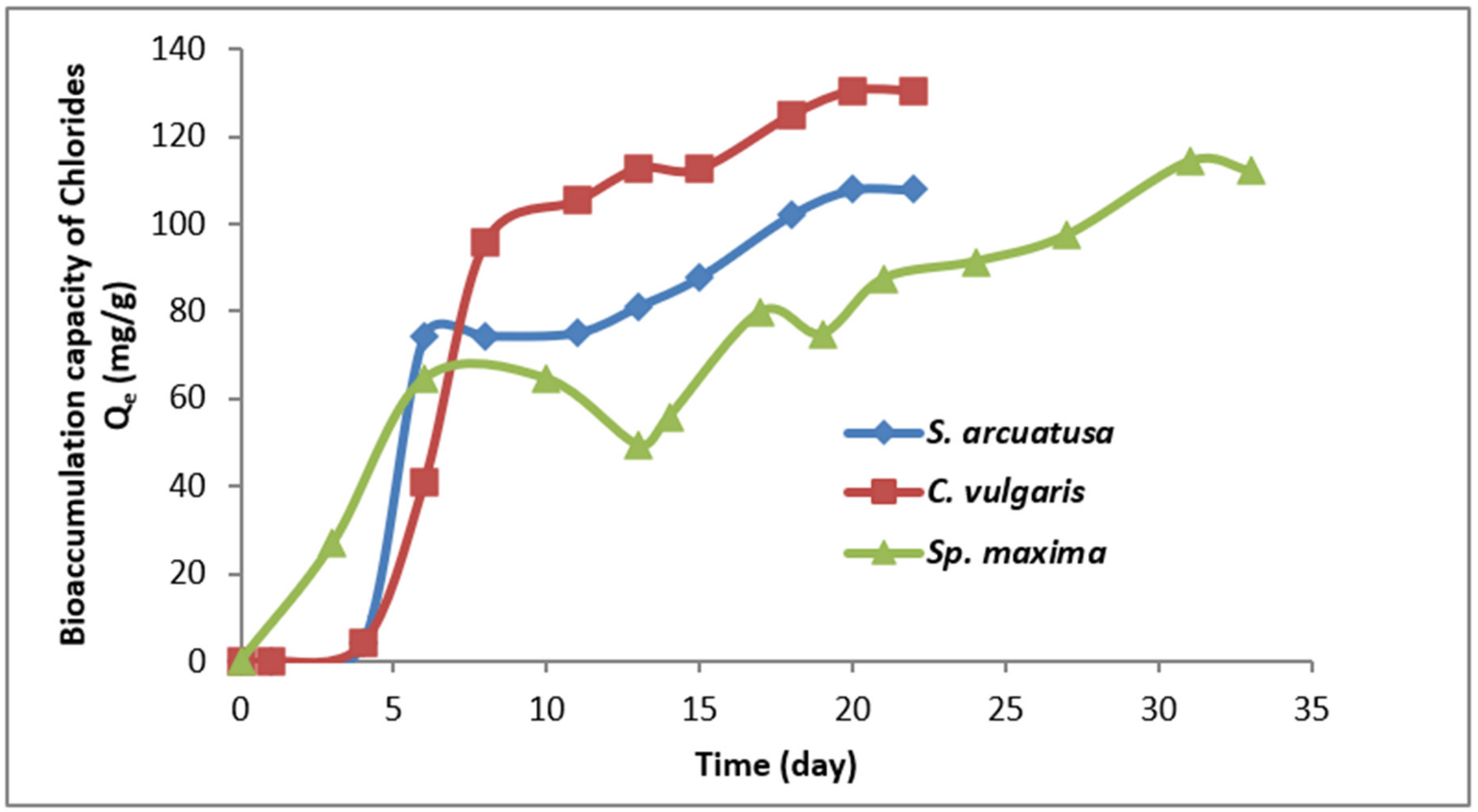
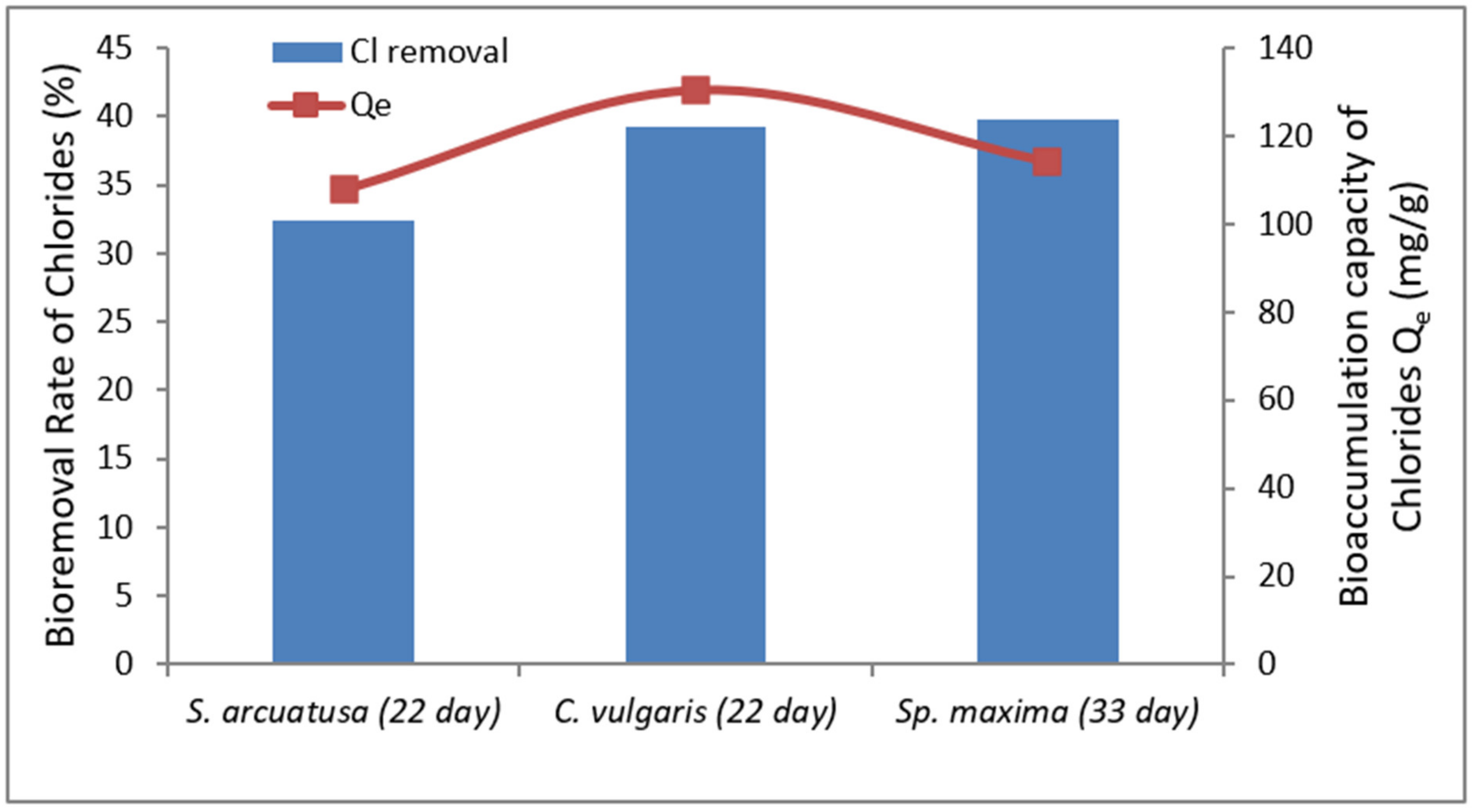
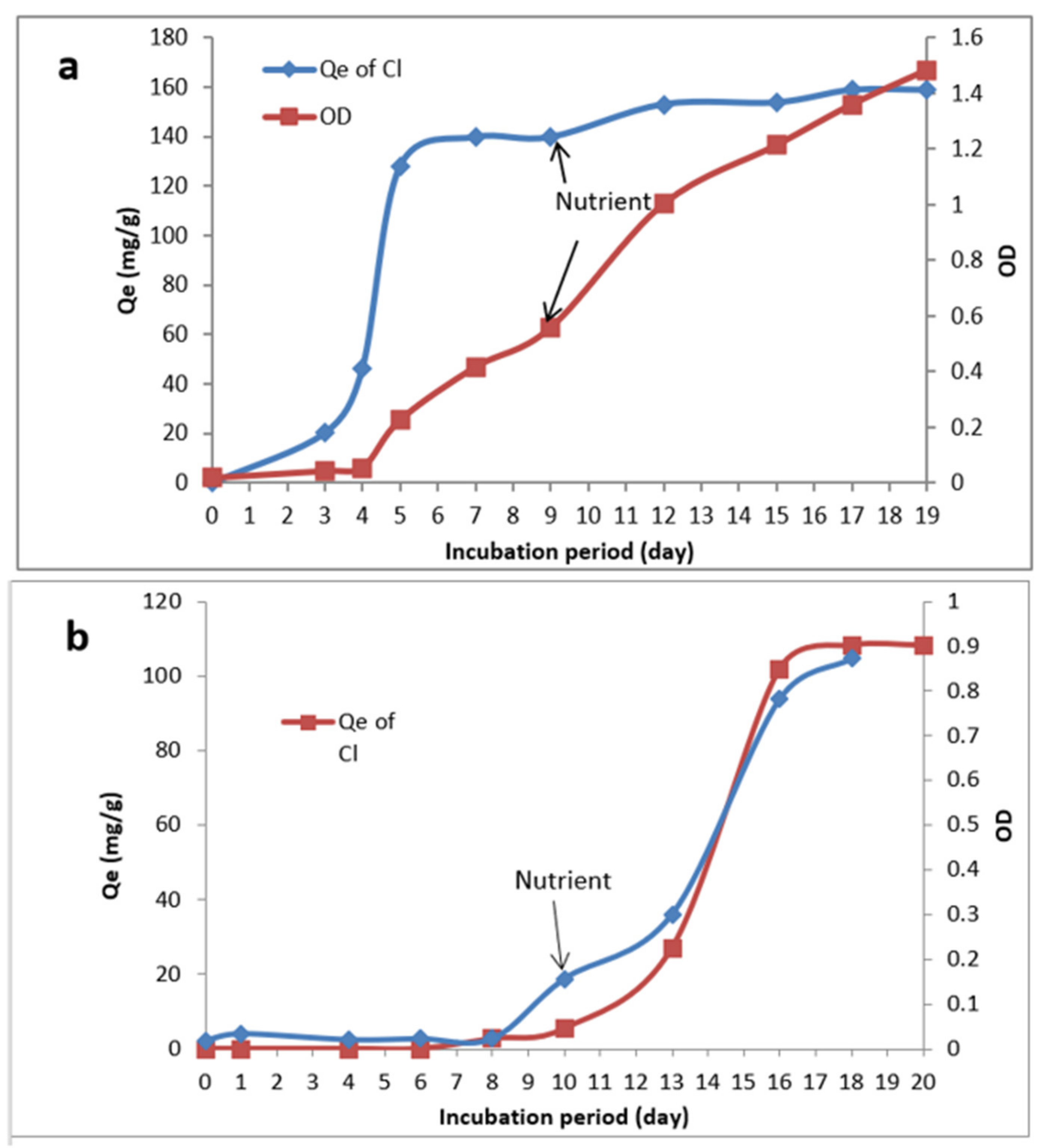

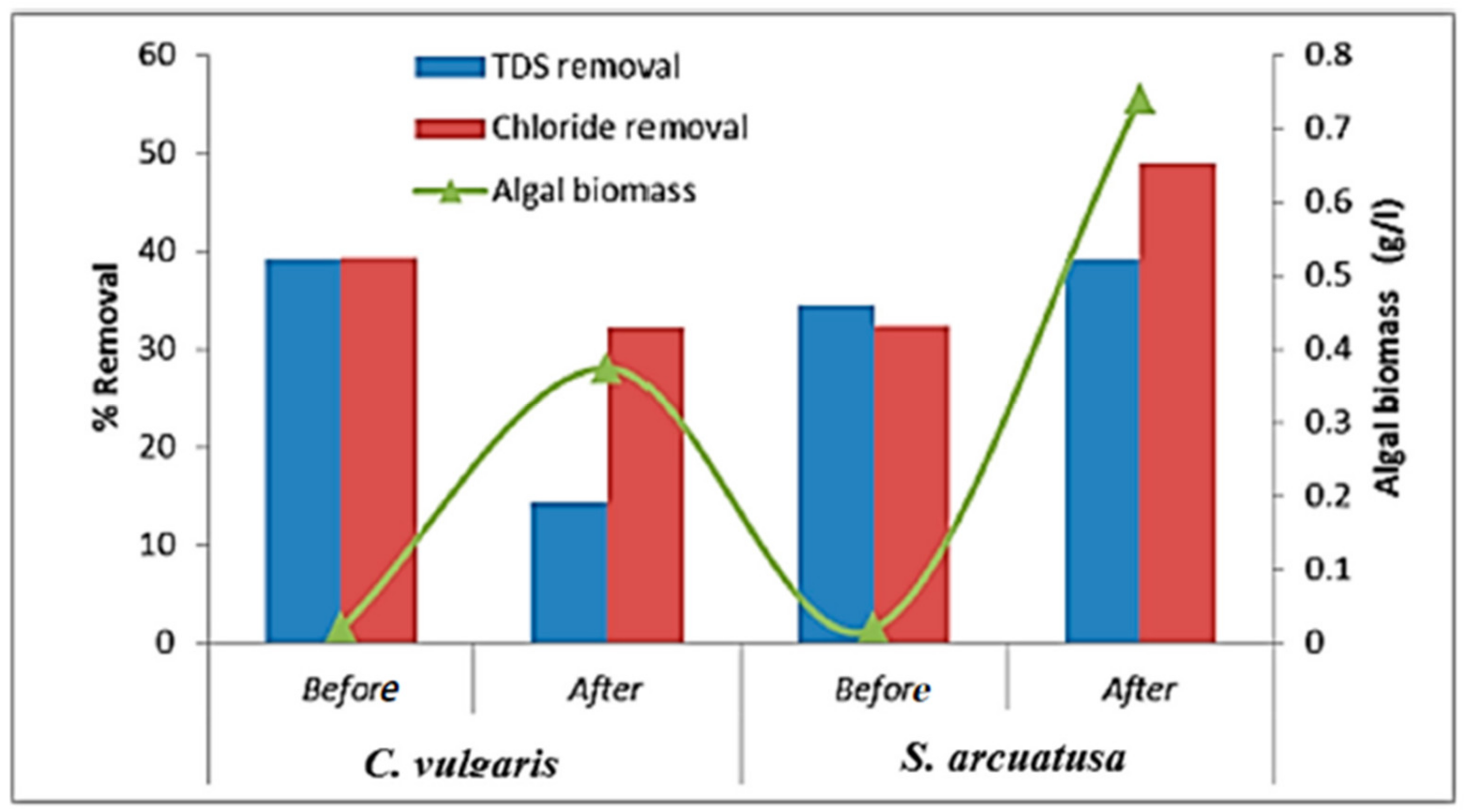
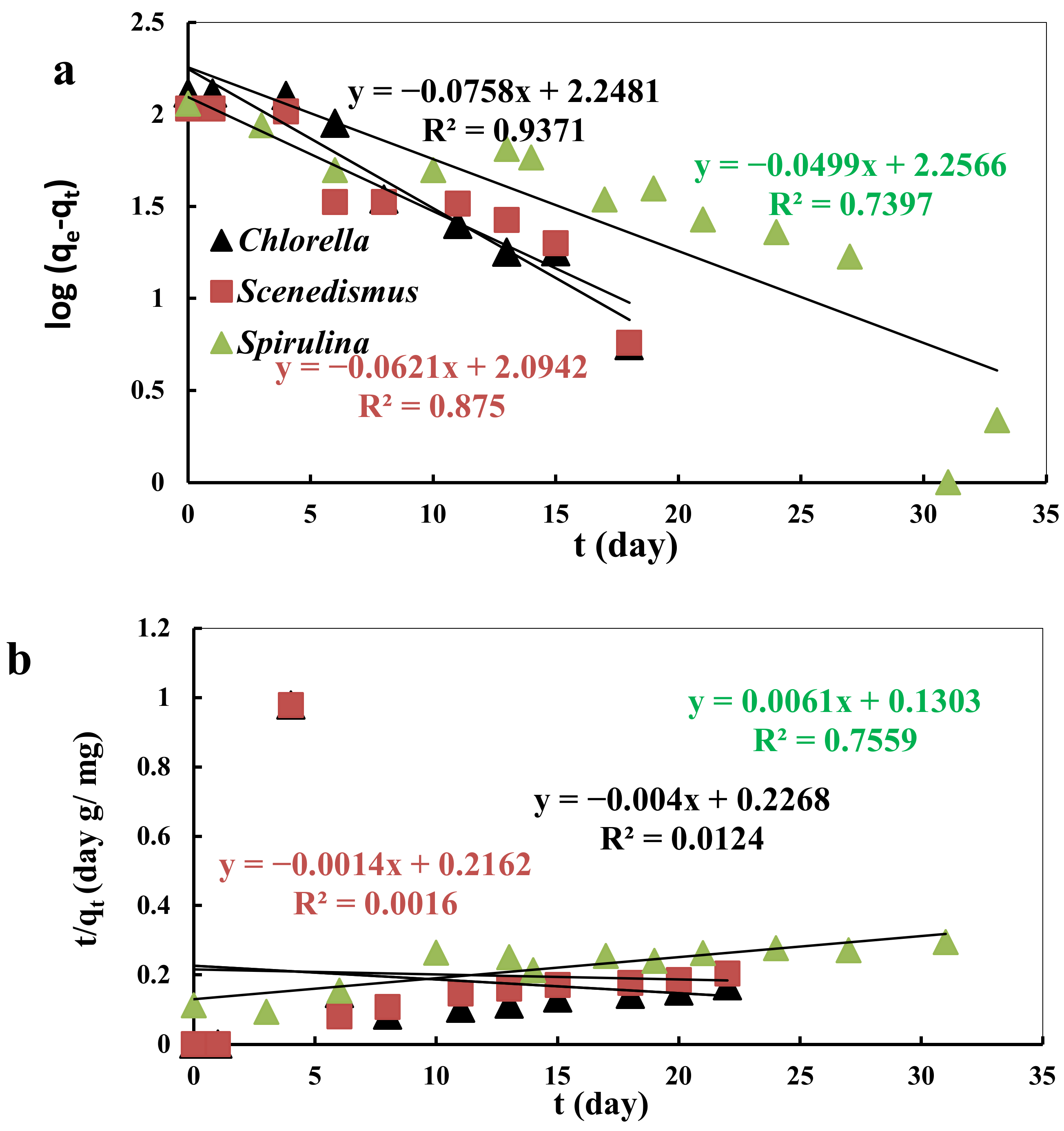

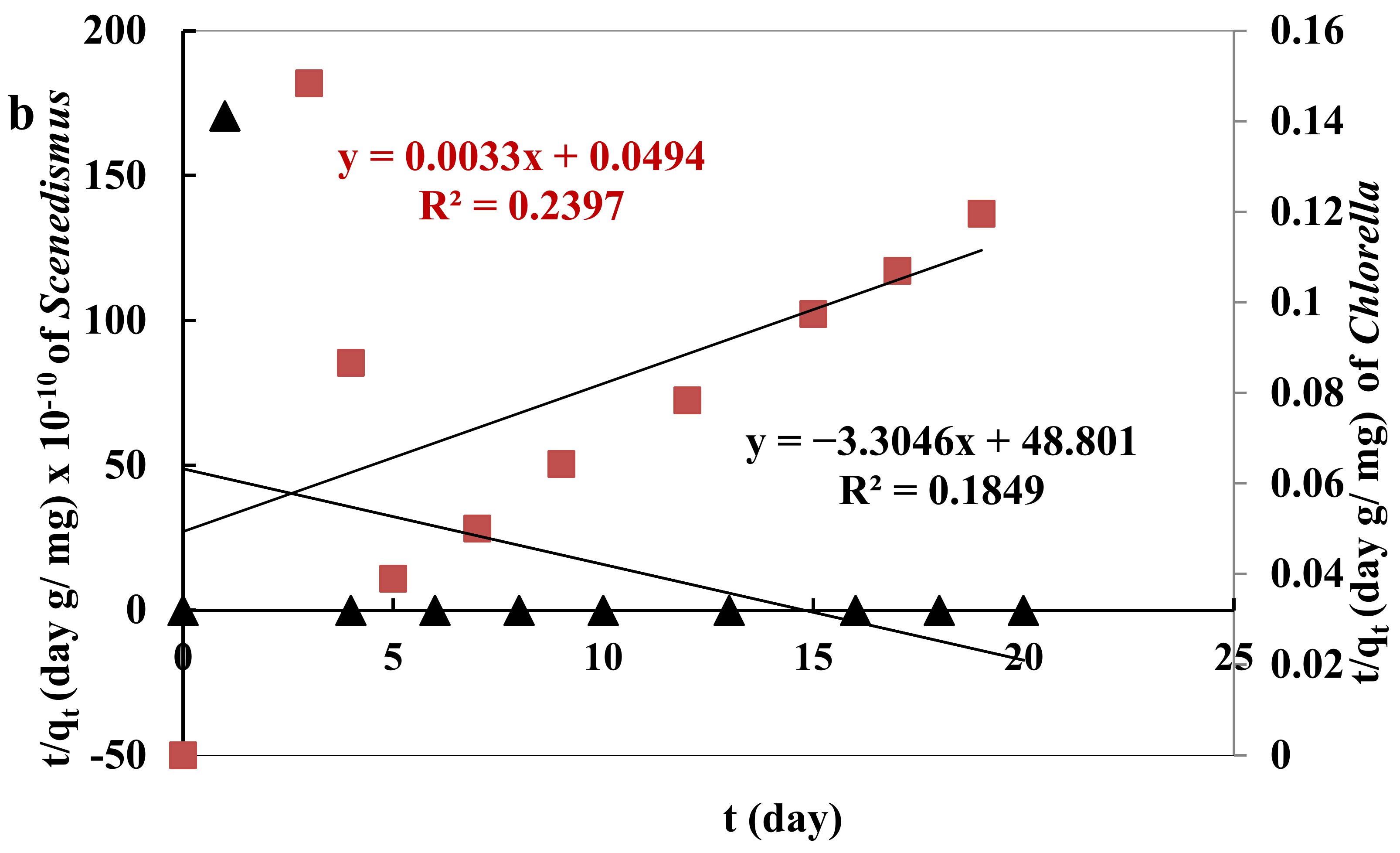

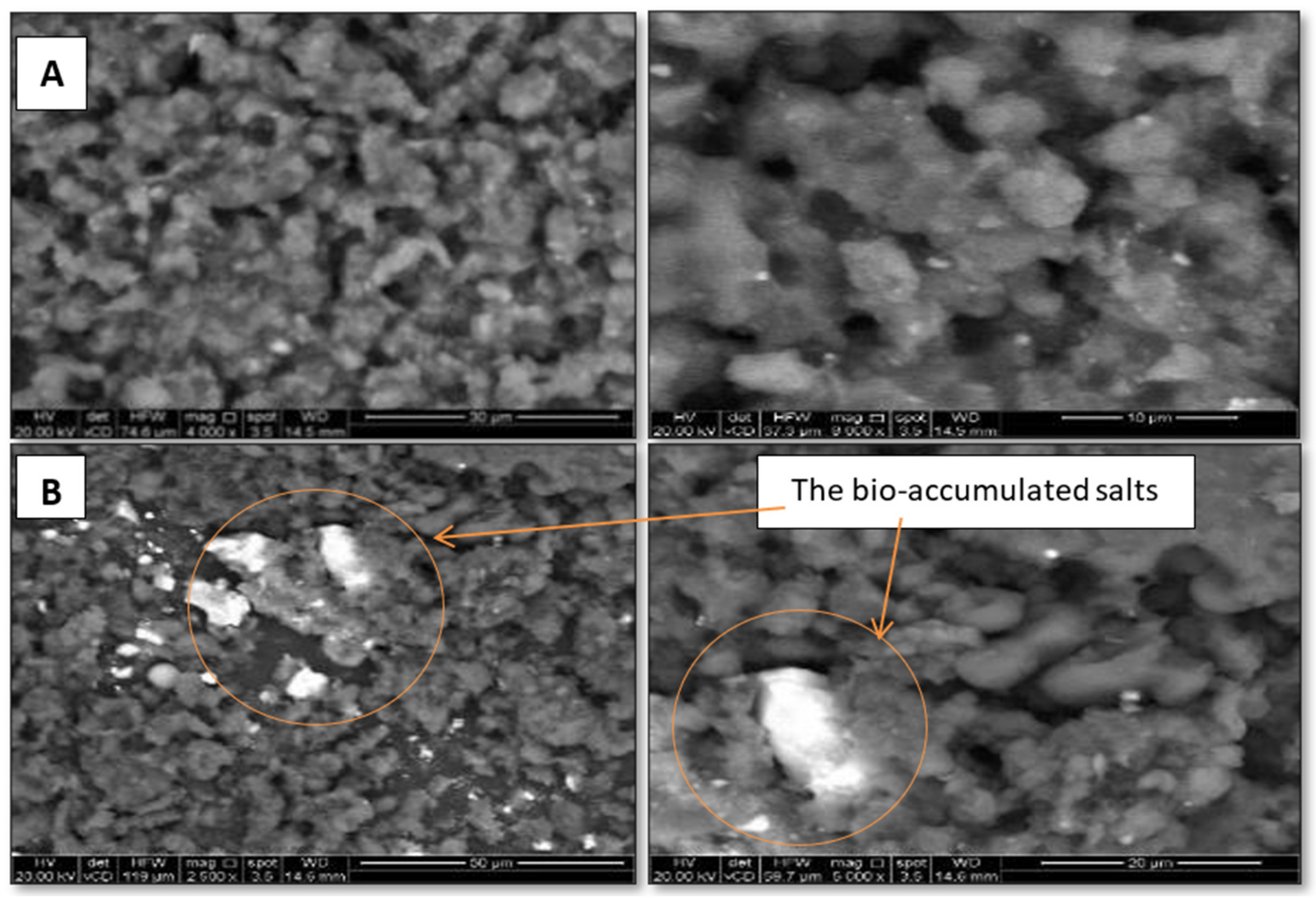
| Stand | Location Name | Latitude | Longitude | Google Map Image |
|---|---|---|---|---|
| 1 | Gayal | 35°02′40.878″ E | 28°06′21.673″ N | 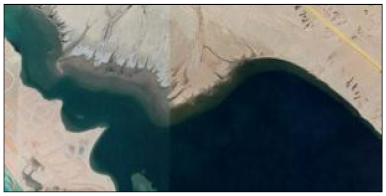 |
| 2 | Sharma | 35°28′19.076″ E | 27°41′10.930″ N | 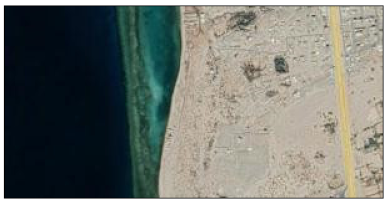 |
| 3 | Al-Muwaileh | 35°43′20.724″ E | 27°19′46.699″ N | 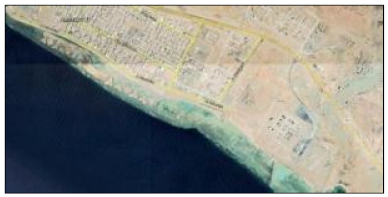 |
| 4 | Duba | 36°27′22.473″ E | 26°13′31.834″ N | 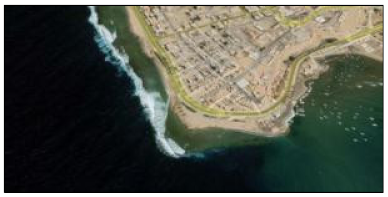 |
| 5 | Umluj | 37°15′08.167″ E | 25°02′07.936″ N | 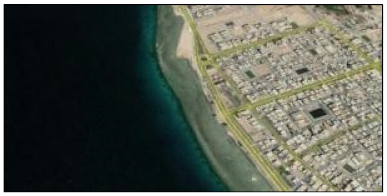 |
| Parameters | Units | Results | ||||
|---|---|---|---|---|---|---|
| 1 | 2 | 3 | 4 | 5 | ||
| pH | 8.6 | 8.52 | 8.7 | 8.5 | 8.61 | |
| Turbidity | NTU | 0.56 | 0.49 | 0.2 | 0.74 | 0.26 |
| Electrical Conductivity (EC) | m mohs/cm | 57.1 | 56.2 | 53.9 | 54.3 | 58.3 |
| Total Dissolved Solids (TDS) | mg/L | 39,970 | 39,340 | 37,730 | 38,010 | 40,810 |
| Total Hardness (as CO32−) | mg/L | 9475 | 7835 | 7415 | 7501 | 9677 |
| Calcium Hardness (as CaCO3) | mg/L | 3000 | 2500 | 2500 | 2500 | 3000 |
| Magnesium Hardness (as MgCO3) | mg/L | 6475 | 5335 | 4915 | 5001 | 6677 |
| Calcium | mg/L | 1200 | 1000 | 1000 | 1000 | 1200 |
| Magnesium | mg/L | 1554 | 1280.4 | 1179.6 | 1200.24 | 1602.48 |
| Chlorides (as Cl−1) | mg/L | 28,425 | 29,505 | 28,245 | 28,505 | 29,032 |
| Sulfates (as SO4−2) | mg/L | 2070 | 2000 | 2070 | 2003 | 2100 |
| Nitrite | mg NO2/L | 0.0 | 0.0 | 0.0 | 0.0 | 0.0 |
| Nitrate | mg NO3/L | 0.01 | 0.01 | 0.01 | 0.01 | 0.01 |
| Phosphate | mg P/L | 0.0 | 0.0 | 0.0 | 0.0 | 0.0 |
| Sodium | mg/L | 13,268 | 13,059 | 12,524 | 12,617 | 13,547 |
| Potassium | mg/L | 1184 | 1166 | 1118 | 1126 | 1209 |
| Pseudo-First Order | Pseudo-Second Order | |||||||
|---|---|---|---|---|---|---|---|---|
| Qe (mg/g) (Cal) | Qe (mg/g) (Exp.) | K1 (min−1) | R2 | Qe (mg/g) (cal.) | Qe (mg/g) (exp.) | K2 (g/mg/min) | R2 | |
| C. vulgaris | 177 | 130.5 | 0.174 | 0.937 | 250 | 130.5 | 0.00007 | 0.0124 |
| S. arcuatusa | 124.2 | 107.8 | 0.143 | 0.875 | 714.3 | 107.8 | 9.065 | 0.0016 |
| Sp. maxima | 180.55 | 114.23 | 0.115 | 0.739 | 133.3 | 114.23 | 0.00069 | 0.7559 |
| Element | Weight (%) | |
|---|---|---|
| Before | After | |
| C | 66.19 | 66.35 |
| O | 26.59 | 26.65 |
| Na+ | 0.94 | 1.15 |
| K+ | 2.38 | 3.32 |
| Mg2+ | 1.53 | 0.49 |
| Ca2+ | 2.35 | 2.02 |
Publisher’s Note: MDPI stays neutral with regard to jurisdictional claims in published maps and institutional affiliations. |
© 2022 by the authors. Licensee MDPI, Basel, Switzerland. This article is an open access article distributed under the terms and conditions of the Creative Commons Attribution (CC BY) license (https://creativecommons.org/licenses/by/4.0/).
Share and Cite
Ghobashy, M.O.I.; Bahattab, O.; Alatawi, A.; Aljohani, M.M.; Helal, M.M.I. A Novel Approach for the Biological Desalination of Major Anions in Seawater Using Three Microalgal Species: A Kinetic Study. Sustainability 2022, 14, 7018. https://doi.org/10.3390/su14127018
Ghobashy MOI, Bahattab O, Alatawi A, Aljohani MM, Helal MMI. A Novel Approach for the Biological Desalination of Major Anions in Seawater Using Three Microalgal Species: A Kinetic Study. Sustainability. 2022; 14(12):7018. https://doi.org/10.3390/su14127018
Chicago/Turabian StyleGhobashy, Madeha O. I., Omar Bahattab, Aishah Alatawi, Meshari M. Aljohani, and Mohamed M. I. Helal. 2022. "A Novel Approach for the Biological Desalination of Major Anions in Seawater Using Three Microalgal Species: A Kinetic Study" Sustainability 14, no. 12: 7018. https://doi.org/10.3390/su14127018
APA StyleGhobashy, M. O. I., Bahattab, O., Alatawi, A., Aljohani, M. M., & Helal, M. M. I. (2022). A Novel Approach for the Biological Desalination of Major Anions in Seawater Using Three Microalgal Species: A Kinetic Study. Sustainability, 14(12), 7018. https://doi.org/10.3390/su14127018







